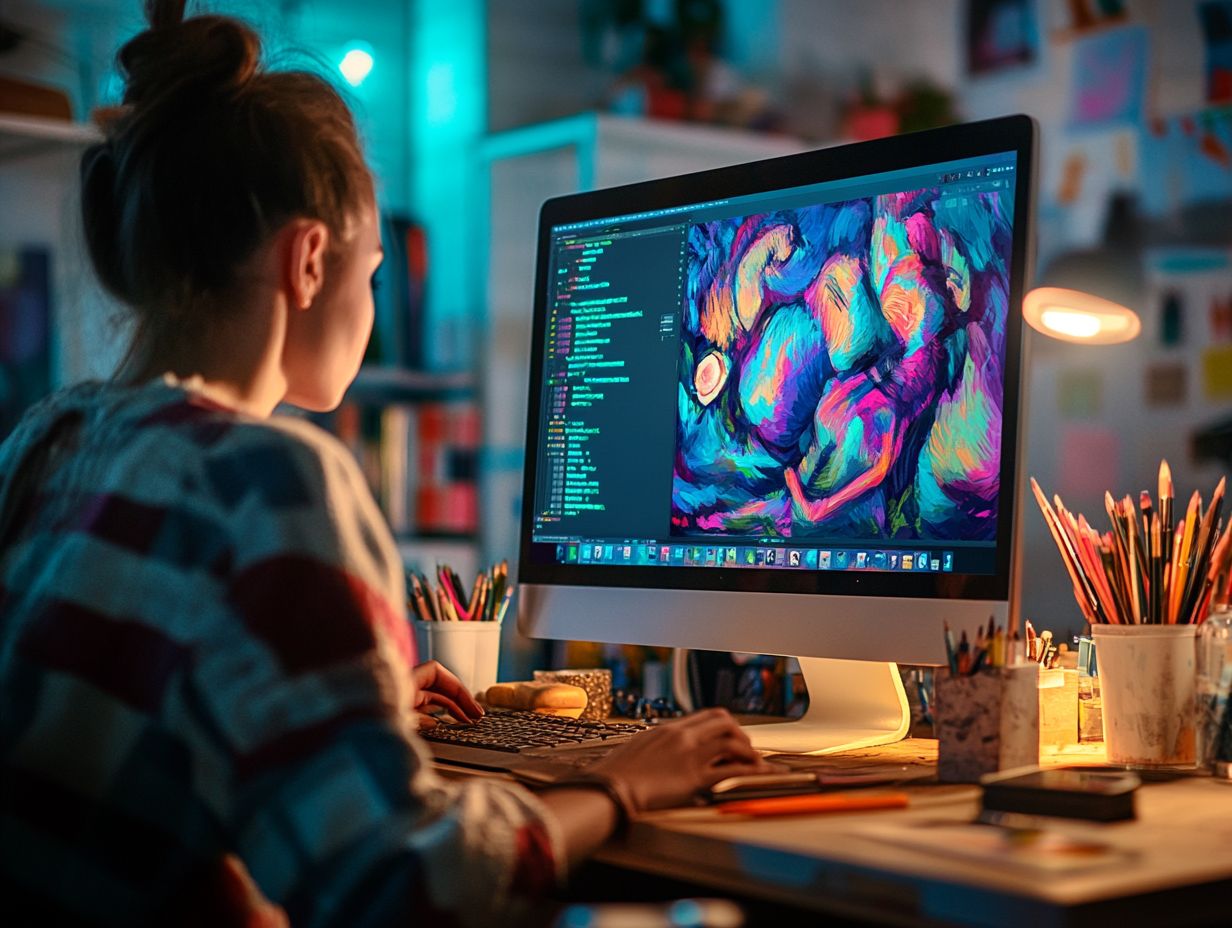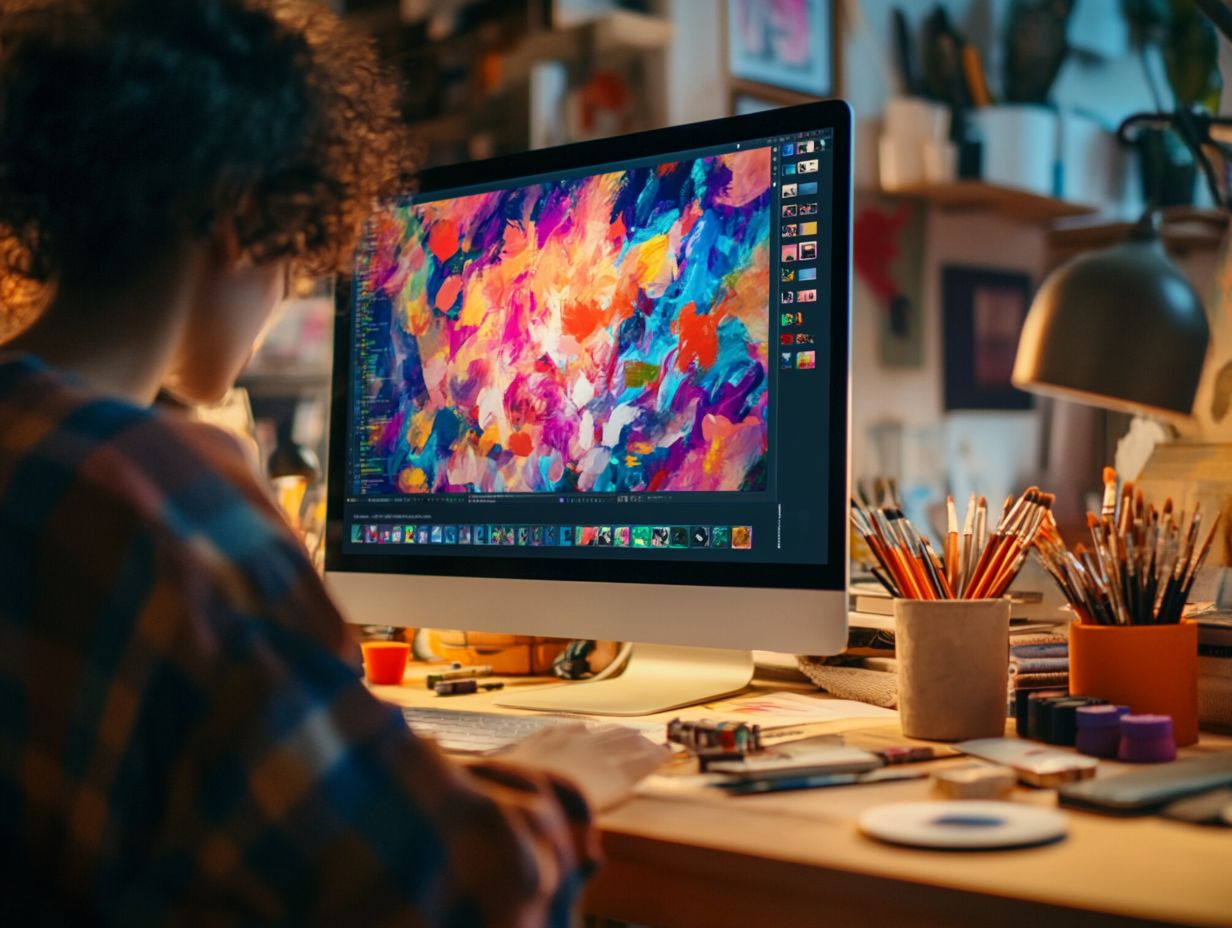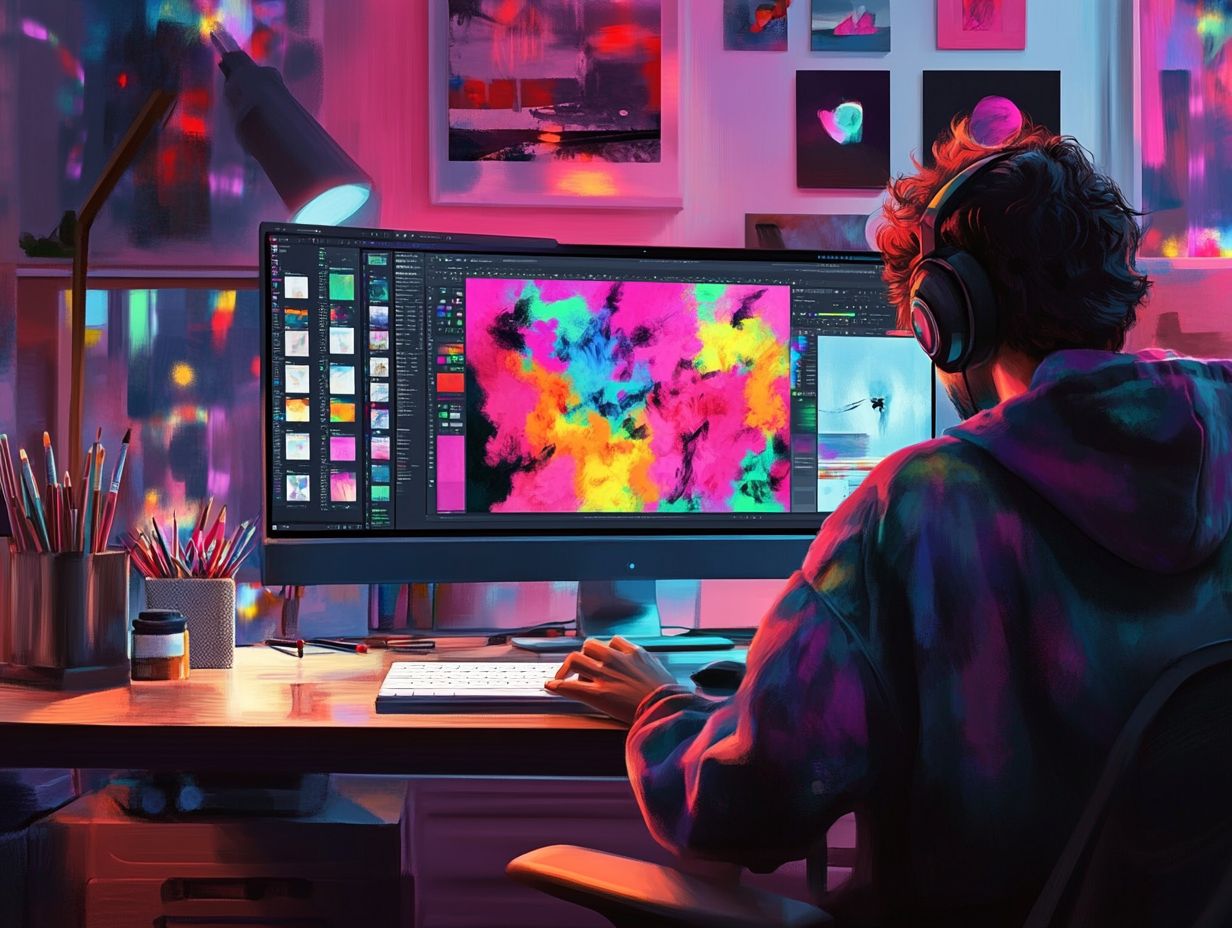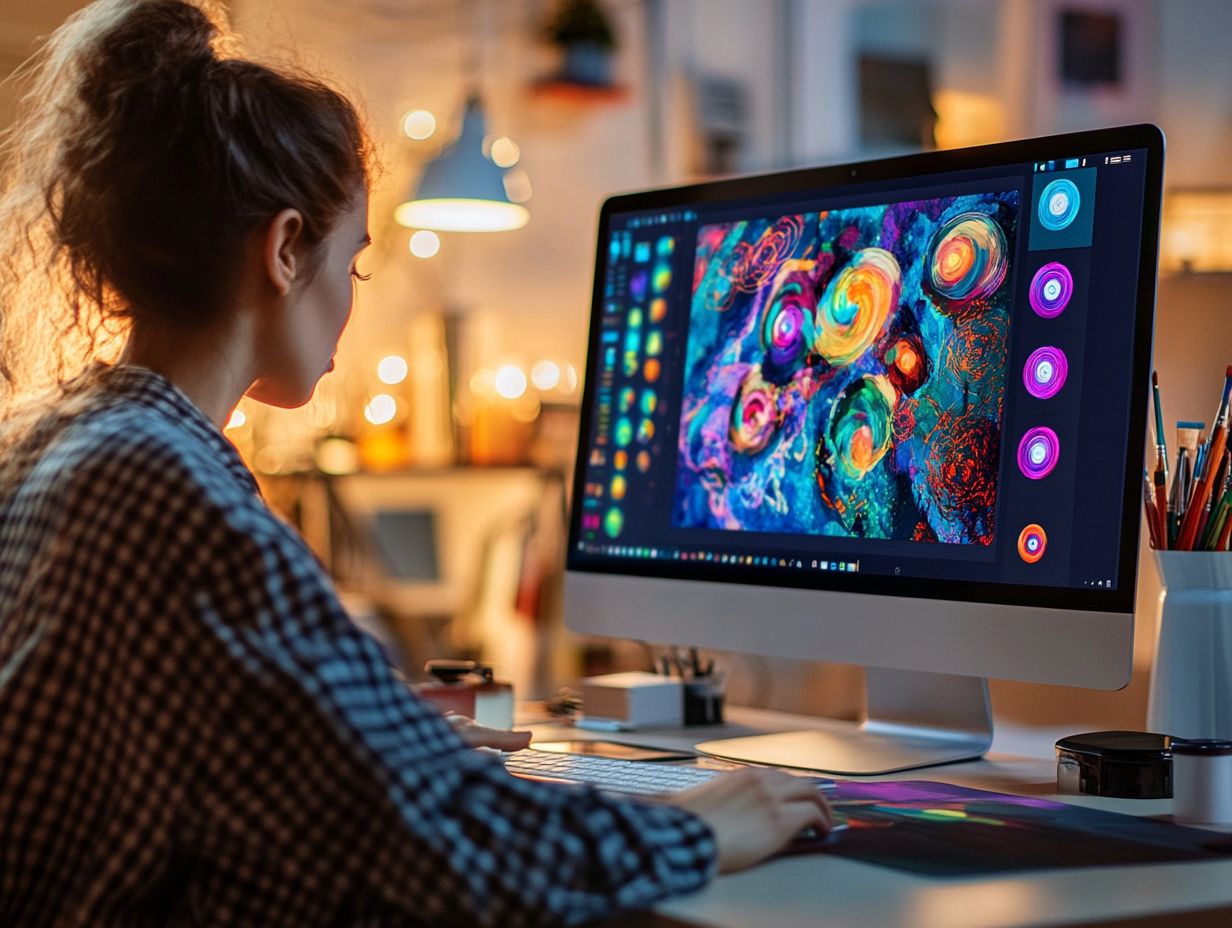Image generation is transforming the way I create and manipulate visuals, providing a variety of creative tools that can convert ideas into stunning images at little to no cost.
This article delves into the benefits of utilizing free tools, emphasizing their cost-effectiveness and time-saving capabilities. I will also discuss different types of image generation technologies, guide you in selecting the right tool for your needs, and share tips for optimizing your results.
Prepare to unlock your creative potential.
What is AI Image Generation?

AI image generation represents a cutting-edge application of artificial intelligence that allows me to create visual content using various machine learning techniques, including online AI image generators and AI-based tools.
This innovative approach utilizes advanced algorithms, including generative models and neural networks, to synthesize images that vary from realistic photographs to abstract digital art, enhancing image quality and resolution scaling.
By leveraging these AI tools, I can enhance my creative processes, producing high-quality images with remarkable precision and artistic effects. This technology not only enriches my work in graphic design but also enables me to explore new dimensions of visual storytelling and personalization.
With the introduction of sophisticated features like style transfer, I can transform existing images into unique interpretations, seamlessly blending various artistic styles and ensuring professional quality.
The interface for many of these AI tools is incredibly user-friendly, enhancing user experience, making them accessible to both seasoned professionals and enthusiastic newcomers alike.
As a digital artist, I now have the opportunity to tap into community resources, tutorials, and forums, which elevate my skills and allow me to share insights on maximizing the potential of AI-driven creativity, benefiting from community support and feedback.
Consequently, the landscape of digital art continues to evolve, fostering diverse expressions and innovative collaborations within the artistic community.
Benefits of Using Free AI Tools
Utilizing free AI tools for image generation presents numerous benefits that can significantly enhance my creative workflow as a designer and digital artist. These tools serve as cost-effective solutions for producing stunning visuals while also granting access to a wealth of online resources that inspire creativity and innovation.
The rise of cloud-based applications allows me to collaborate easily on projects and share high-resolution images, which greatly increases user engagement, compatibility, and fosters a vibrant community of creators.
Additionally, many of these AI options feature user-friendly interfaces, making them accessible to both newcomers and seasoned professionals, enhancing accessibility and adaptive learning.
Cost-Effective Solutions
Cost-effective solutions in the field of AI image generation present an invaluable opportunity for both individuals and businesses to access high-quality visual content without excessive financial strain, with options for free resources and royalty-free images.
I utilize free AI tools and software applications that enable me to engage in image editing, photo enhancement, and graphic design without the burden of costly licenses or subscriptions. Many of these tools operate under creative commons licensing, allowing me to create copyright-free images that can be utilized across various platforms, including social media and professional portfolios.
These platforms typically feature user-friendly interfaces that simplify the creative process, making it accessible even for those with minimal graphic design experience. Tools such as DeepAI and Artbreeder enable me by providing customizable templates and the ability to manipulate image attributes, resulting in unique and personalized outcomes.
The cost savings afforded by these free resources allow me to allocate my budget more effectively, directing funds toward marketing or further project development. This significantly reduces the financial barriers that have traditionally limited access to quality visual content.
Time-Saving Capabilities

The time-saving capabilities of AI image generation tools have significantly streamlined my creative process as a graphic designer, allowing me to concentrate more on my core tasks. By leveraging AI-driven software applications, I can quickly generate high-resolution images, apply artistic effects, and experiment with design elements without extensive manual effort.
This efficiency not only enhances my user experience but also facilitates seamless project collaboration, enabling my team to produce high-quality visuals in a fraction of the time compared to traditional methods, benefiting from rapid prototyping and community feedback.
Specific features, such as user-friendly drag-and-drop interfaces, make it incredibly simple for me to assemble my ideas into cohesive visuals with minimal hassle.
The availability of customizable design templates allows me to kickstart projects quickly, eliminating the often time-consuming brainstorming phase. Additionally, automated enhancements ensure that my final output meets high standards of quality, as these tools can instantly suggest optimizations and adjustments.
As a result, I can maximize my productivity, spending less time on routine tasks and more on innovative thinking and experimentation.
Types of AI Image Generation Tools
I have access to a diverse array of AI image generation tools available today, each utilizing unique technologies, including generative models and neural networks, to create stunning visual content.
From advanced photo manipulation software to innovative online platforms that offer features like style transfer and image filters, these tools cater to various creative needs and preferences, including AI creativity and multimedia content.
As a designer, I can choose from a multitude of applications that focus on different aspects of image generation, whether it involves enhancing photo quality, creating illustrations, or developing interactive media, all while ensuring mobile compatibility and scalability.
This toolkit of AI-driven solutions enables me to push the boundaries of my creativity and explore new artistic effects.
Generative Adversarial Networks (GANs)
Generative Adversarial Networks (GANs) represent a revolutionary advancement in AI image generation, allowing me to create high-quality images through a sophisticated machine learning process. Comprising two neural networks that function collaboratively, the generator produces images while the discriminator assesses their authenticity.
This innovative framework not only improves image synthesis but also facilitates the creation of realistic visuals suitable for a variety of applications, ranging from digital art to marketing materials. By utilizing GANs, I can achieve unparalleled levels of detail and quality in my work.
The capacity of GANs to generate high-resolution images opens up new opportunities across multiple industries, including fashion, gaming, and virtual reality.
For example, I see fashion designers using GANs to create unique clothing patterns and styles, enabling them to visualize designs before moving to production. Similarly, the gaming industry employs these networks to craft immersive environments and lifelike characters, enhancing the overall player experience.
The impact of GANs goes beyond mere image creation; they enable artists and designers to explore innovative concepts, pushing creative boundaries and inspiring fresh forms of artistic expression. Integrating such advanced technology into my creative process not only streamlines workflows but also significantly enriches the final output.
Neural Style Transfer (NST)

Neural Style Transfer (NST) represents a transformative technique in AI image generation, allowing me to apply the visual style of one image to another and create captivating artistic effects. By leveraging deep learning algorithms, I can transform ordinary photographs into stunning pieces of digital art that reflect the characteristics of renowned paintings or unique artistic styles.
This capability not only enhances my image editing but also enriches my visual storytelling, enabling me to convey emotions and narratives through my art in innovative ways.
The essence of NST lies in its ability to separate content from style, allowing me to maintain the inherent subject matter of my original images while dressing them in the aesthetic of my chosen influences. This process opens a world of creative possibilities, enabling me to juxtapose modern photography with the vibrant brush strokes of impressionism or the stark contrasts found in expressionism.
As an artist and designer, I find myself increasingly adopting this method for projects that require a blend of creativity and technology. The result is artwork that is not only visually striking but also deeply resonant with viewers.
In a landscape where digital art continues to evolve, NST enables me to push boundaries and explore my unique artistic vision.
Deep Dream
Deep Dream is a compelling image generation technique that employs machine learning algorithms to create dream-like visuals, often featuring surrealistic and psychedelic artistic effects. Initially developed by Google, Deep Dream analyzes and enhances images by highlighting the patterns and features recognized by the neural network, resulting in unique and visually striking outputs.
This technique opens up a realm of creativity for me as an artist and designer, enabling the exploration of unconventional styles and the expansion of traditional image creation boundaries.
By manipulating an image’s features through multiple layers of abstraction, I can produce complex and visually captivating pieces that challenge viewers’ perceptions.
This process allows me to infuse my work with a distinctive flair, making it feasible to incorporate these dream-like visuals into various creative projects, such as album covers, visual storytelling, and advertising campaigns.
The ability to generate variations of a single image presents a wide array of artistic possibilities, fostering collaboration between technology and human creativity, ultimately redefining the landscape of digital art and inspiring a new generation of imaginative expression.
How to Choose the Right AI Tool for Your Needs
Selecting the appropriate AI tool for my online AI image generators and photo editing needs requires careful consideration of several factors that can greatly influence my creative process.
With numerous options available, it is essential for me to evaluate these tools based on user experience, customization capabilities, and their compatibility with my existing workflow.
Whether my focus is on enhancing graphic design projects, creating unique visual assets, or exploring innovative digital art techniques, choosing an AI tool that aligns with my specific requirements can significantly elevate my work and facilitate seamless project collaboration.
Factors to Consider

When I select an AI image generation tool, I consider several critical factors that can significantly influence the effectiveness and quality of my designs. Key aspects include the tool’s user engagement features, the quality of images it produces, and its compatibility with various design software and software applications, ensuring cross-platform functionality.
I find it essential to evaluate the customization options available to tailor the tool to my specific creative needs and ensure it aligns with my workflow and project goals.
User engagement features are vital in determining how effectively a tool interacts with its users. I look for intuitive interfaces, helpful tutorials, and responsive support that facilitate my creative process.
Similarly, the quality of the images produced directly impacts the visual appeal and professionalism of my final designs; thus, I carefully assess resolution, color accuracy, and detail.
A tool’s compatibility with my existing design software enhances overall design efficiency, allowing for seamless integration into my workflow and minimizing disruptions while maximizing productivity.
Additionally, the ability to customize options enables me to personalize my experience, ensuring the tool meets my unique project requirements effectively.
Tips for Generating the Best Images with AI Tools
To generate the best images with AI tools, I find that employing effective strategies can significantly enhance the quality and relevance of my visual content.
Understanding the intricacies of input and output parameters allows me to fine-tune the AI’s capabilities, leading to more accurate and aesthetically pleasing images. Additionally, optimizing these parameters not only improves the user experience but also maximizes the creative potential of the tools.
This enables me, as an artist or designer, to produce captivating visuals that truly resonate with my audience.
Understanding Input and Output
Understanding the relationship between input and output in AI image generation tools is essential for achieving the desired results and enhancing the overall user experience. By carefully selecting inputs—such as images, text prompts, or parameters—I can effectively guide the AI’s output, ensuring it aligns with my creative vision. This approach not only offers greater customization options but also aids in generating images that meet specific quality standards and artistic effects.
The type of input I provide directly influences the quality and style of the images produced, allowing me to explore a wide range of creative possibilities. For example, a detailed textual prompt can lead to more intricate and tailored visuals, while a simple or vague input may yield more generic outcomes.
Best practices in utilizing these tools include:
- Experimenting with different combinations of inputs
- Adjusting parameters such as style or color balance
By doing so, I can refine my approach and discover unique outputs that resonate with my artistic intent, ultimately resulting in personalized and compelling imagery.
Optimizing Parameters for Desired Results
Optimizing parameters in AI image generation is a crucial step in producing high-quality images that align with my project’s specific requirements, employing free AI tools and tutorials for beginners.
By adjusting settings such as resolution, style strength, and filter effects, I can tailor the output to achieve my desired results, whether that involves vibrant colors, intricate details, or specific artistic effects.
This level of customization not only enhances the visual quality of the images but also maximizes the creative potential of the AI tools I utilize.
To effectively navigate this process, I find it essential to understand how various parameters interact with one another. For instance, increasing the resolution can significantly improve clarity and detail, but it may also extend processing time.
Similarly, adjusting the style strength can either enhance the artistic flair or overshadow the underlying image, depending on the combination I choose. Experimentation is key; I often create several iterations while modifying individual settings to observe their impacts firsthand.
Incorporating relevant keywords into my experimentation framework helps me maintain focus on my desired outcomes, ensuring that the generated images closely align with my project’s vision.
